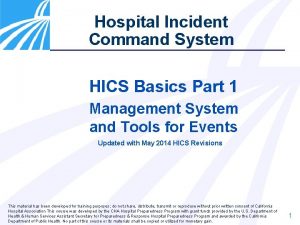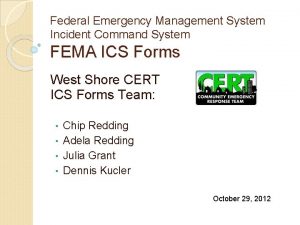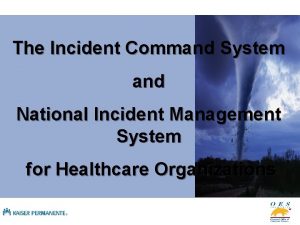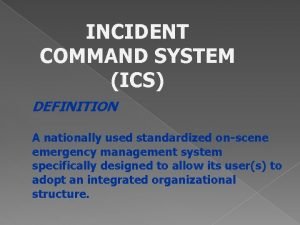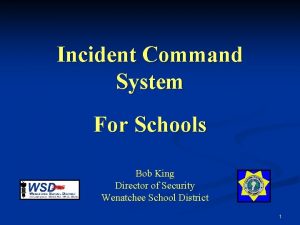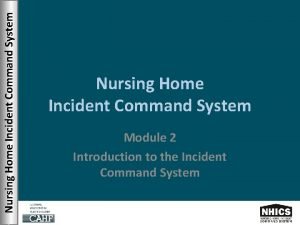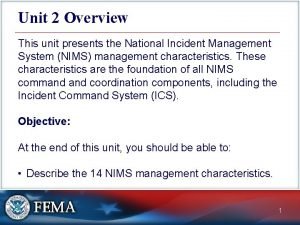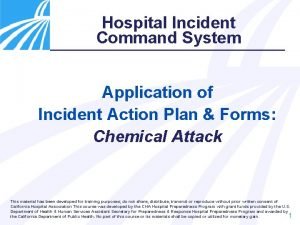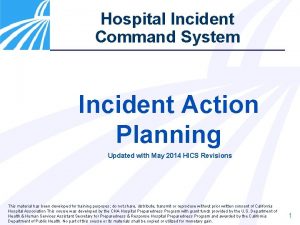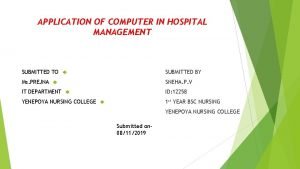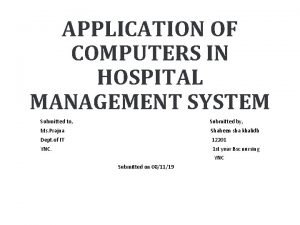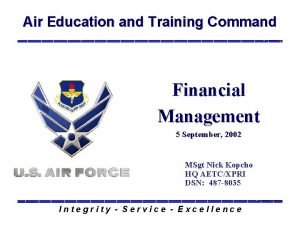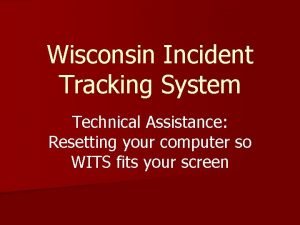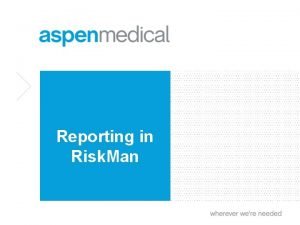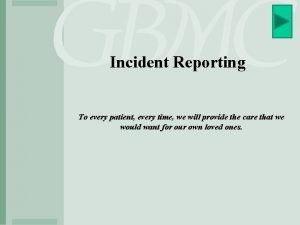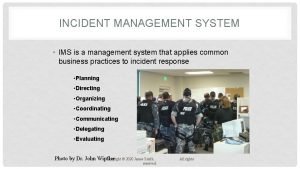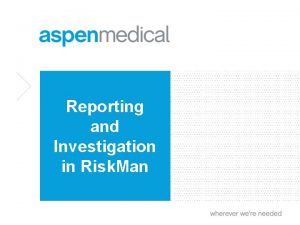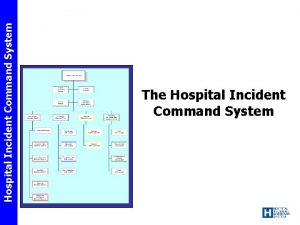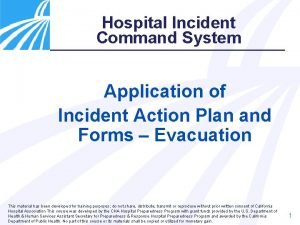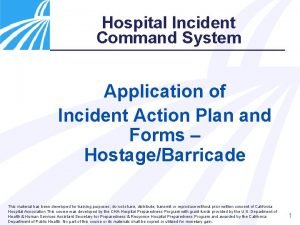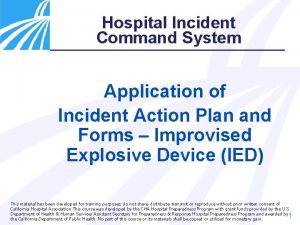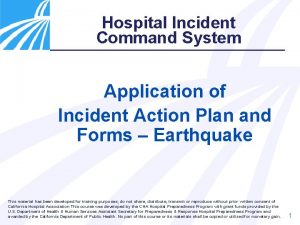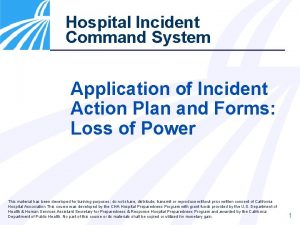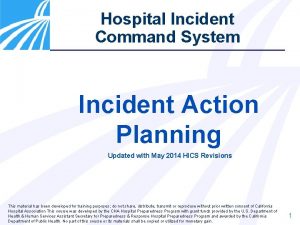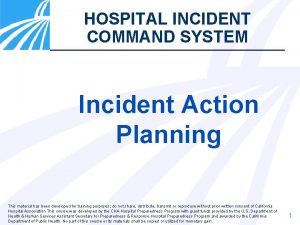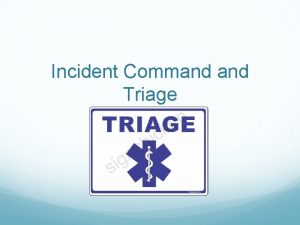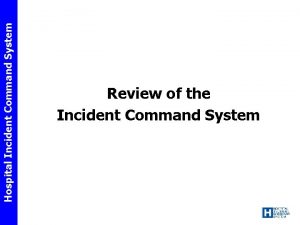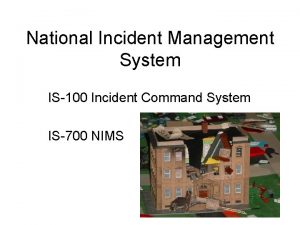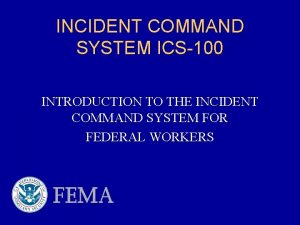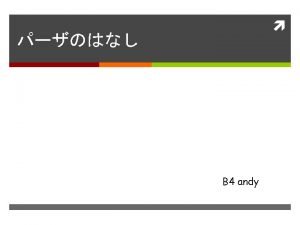Hospital Incident Command System Application of Incident Action


































- Slides: 34

Hospital Incident Command System Application of Incident Action Plan and Forms – Loss of Water This material has been developed for training purposes; do not share, distribute, transmit or reproduce without prior written consent of California Hospital Association This course was developed by the CHA Hospital Preparedness Program with grant funds provided by the U. S. Department of Health & Human Services Assistant Secretary for Preparedness & Response Hospital Preparedness Program and awarded by the California Department of Public Health. No part of this course or its materials shall be copied or utilized for monetary gain. 1

Objectives • Demonstrate the Incident Action Planning Process • Demonstrate the use of HICS Forms • Implement the use of the Incident Response Guides 2

Scenario Based Implementation • Discuss and rehearse practical implementation of the Incident Action Planning process utilizing HICS forms and the Incident Response Guides • Utilize a “Table Top” learning process 3

Incident Action Planning 1. Assess the Situation 2. Set the Operational Period 3. Determine Safety Priorities & Establish Incident Objectives 4. Determine Branch/Section Objectives 5. Determine Strategies & Tactics 6. Determine Needed Resources 7. Issue Assignments 8. Implement Actions 9. Reassess & Adjust Plans 4

Scenario • Without warning, the main water supply line to the hospital breaks, disrupting water service to the entire facility • The hospital’s water systems, including potable water supply are non-functional • Local water sources and vendors are not impacted • Large volume of water is flowing out from beneath pavement on main roadway in front of hospital causing access challenges (no hospital flooding) 5

Scenario • Services, including food and radiology are disrupted • Toilets and hand washing areas are not functioning and alternate methods must be provided • Time: 2300 • Weather: Clear, 68º F, no winds 6

First Actions • Water has been disrupted for 15 minutes • Time until repaired: Unknown ü Is this an incident? ü What are your first actions? ü Who is in charge? 7

Incident Action Planning Step 1: Assess the Situation • Use HICS form 214: Operational Log • Complete HICS form 201: Incident Briefing ü Event History and Current Actions Summary • Begin form 202: Incident Objectives ü Weather/environmental implications for period 8

Which Positions to Activate? 9

Immediate Time Period Position Incident Commander Public Information Officer Liaison Officer Safety Officer Operations Section Chief Medical Care Branch Director Infrastructure Branch Director Security Branch Director Business Continuity Branch Director Patient Family Assistance Branch Dir. Immediate X X Intermediate X X Extended X X Recovery X X X X X X X X X X X X X X X X Planning Section Chief Resources Unit Leader Situation Unit Leader Documentation Unit Leader Demobilization Unit Leader X X X Logistics Section Chief Service Branch Director Support Branch Director X X X Finance /Administration Section Chief Time Unit Leader Procurement Unit Leader Compensation/Claims Unit Leader Cost Unit Leader X 10

Naming the Incident • The Incident Commander names the incident • If the incident is a community-based incident, the appropriate jurisdiction will name the incident (e. g. , county, city, EMS) • The incident name should be documented on all forms 11

Incident Action Planning Step 2: Set the Operational Period • HICS form 202: Incident Objectives ü Operational Period Date/Time • Incident Commander sets the Operational Period • Based on number of simultaneous activities • How quickly the situation is changing • An Operational Period breaks the incident down into manageable timeframes 12

Incident Action Planning Step 3: Determine Safety Priorities & Incident Objectives • Identify Command & Control Objectives (these are the overarching objectives that will last throughout the whole response) • HICS form 202: Incident Objectives 13

Control Objectives Utilize the Incident Response Guide Utility Loss: Identify extent of outage and consider evacuation Maintain patient care capabilities Minimize impact on hospital operations and clinical services Communicate the situation status to patients, staff, and the public 14

Scenario Update #1 • It has been 30 minutes since the water main break • The hospital is only accessible to emergency vehicles 15

Side Note: Safety Officer Tasks • Assess the Safety issues • What hazards exist and what precautions need to be taken ü Ensure safe entry/exit of essential personnel to and from hospital ü Ensure safety of patients, visitors, staff in nonimpacted areas ü Ensure hydration/sanitation is addressed • Complete form 215 A – Incident Action Plan Safety Analysis 16

Side Note: Public Information Officer Tasks • Prepare a statement for the media • Prepare a statement for the staff, patients and visitors (e. g. , situation, status, safety precautions, next update time) • The statements need approval from the Incident Commander • Coordinate consistent messaging with the Joint Information Center (JIC) or with law enforcement PIO 17

Side Note: Liaison Officer • Who or what entity operates as the county contact/MHOAC, and how do you contact? • Who should be notified of the situation? • Who should be notified of hospital status? Bed status? How? • Who is the source of resources in your local plan? (e. g. , local EMS Department Operations Center, PHD Department Operations Center, County/City Emergency Operations Center) • Needs should be determined prior to the incident 18

Side Note: Documenting your Actions • Utilize HICS forms • Form 214 - Operational Log 19

Incident Action Planning Step 4: Determine Branch/Section Objectives • Document on HICS 204 – Assignment List • They are based on the Incident Objectives • These are based on what is desired to be achieved by the Section in that operational period • Objectives need to be SMART (Simple, Measurable, Achievable, Realistic, Time Sensitive & Task Oriented) 20

Branch/Section Objectives • A common problem during exercises is that Sections/Branches don’t develop their objectives promptly • Report top 3 objectives 21

Incident Action Planning Step 5: Determine Strategies & Tactics • Strategies & tactics are how your Branch/Section is going to achieve the objectives • What actions do you need to take? • Use your facility response plans and Incident Response Guides • Record strategies & tactics on form 204 – Branch Assignment List 22

Incident Action Planning Step 6: Determine Needed Resources • What equipment and/or supplies do you need? • What personnel resources do you need? • Do you need transport resources ? • Document resource activities: ü ü ü Resources assigned (form 204) Resource requests (form 213) Actions taken to utilize and obtain resources (form 214) 23

Incident Action Planning Step 7: Issue Assignments • Who will be assigned to the units? • Fill in the assignments on form 204 – Assignment List • Are there other branches that need activated? 24

Incident Action Planning • For the first Operational Period the Incident Action Plan should be done within 30 -45 minutes • What makes up the Incident Action Plan? ü ü ü Form 201 - Incident Briefing Form 202 - Incident Objectives Form 203 - Incident Assignments Form 204 - Branch Assignments Form 215 A - Incident Action Plan Safety Analysis • The Planning Section compiles the forms to create the Incident Action Plans 25

IAP Quick Start • New form • Can be used for small incidents • Or for a rapid start to a large incident and then expand out on individual HICS forms • Great for smaller pre-planned events 26

IAP Cover Sheet • Can be used for the IAP Quick Start or full Incident Action Plan forms • Can make different colors if you want to differentiate Operational Periods 27

Incident Action Planning Step 8: Implement Actions • Put your activities / plans into action • What are some of these activities? 28

Scenario Update #2 • It is now 0030 – 1. 5 hrs into the incident • Utility workers expect to repair the damage and restore water service to the hospital within 10 – 12 hours • What are your major concerns? 29

Incident Action Planning Step 9: Reassess & Adjust Plans • Towards the end of the operational period, you will need to evaluate status • Repeat steps 1 -8 • Update the forms • Evaluate and/or update your Branch/Section Objectives • This creates your Incident Action Plan (game plan) for the next operational period 30

Scenario Update #3 • It is now 4 hours into the incident • Utility repair personnel have encountered complications and report water may not be restored for 3 days • What issues should be considered? 31

How are we doing? What are things we need to remember to do? ü ü Share information Recovery / Restoration After Action Report Corrective Actions Plan 32

Questions? 33

HICS Basics Part 2 Application of Incident Action Plan and Forms Loss of Water developed by the California Hospital Association’s Hospital Preparedness Program www. calhospitalprepare. org This material has been developed for training purposes; do not share, distribute, transmit or reproduce without prior written consent of California Hospital Association This course was developed by the CHA Hospital Preparedness Program with grant funds provided by the U. S. Department of Health & Human Services Assistant Secretary for Preparedness & Response Hospital Preparedness Program and awarded by the California Department of Public Health. No part of this course or its materials shall be copied or utilized for monetary gain. 34
 Examples of hics
Examples of hics Fema unified command
Fema unified command Hospital incident command system powerpoint
Hospital incident command system powerpoint Ics definition
Ics definition Incident command system schools
Incident command system schools Nursing home incident command system
Nursing home incident command system Hospital management system patient registration form
Hospital management system patient registration form Depending on the incident size and complexity
Depending on the incident size and complexity Singular incident command
Singular incident command Incident objectives that drive incident operations
Incident objectives that drive incident operations Define hospital and hospital pharmacy
Define hospital and hospital pharmacy Supports the incident action planning process
Supports the incident action planning process System architecture diagram for hospital management system
System architecture diagram for hospital management system Uses of
Uses of Application of computer in hospitals
Application of computer in hospitals Application of computer in hospital
Application of computer in hospital What is plot sequence
What is plot sequence Rising action
Rising action Five stages of plot development
Five stages of plot development Exposition in a rose for emily
Exposition in a rose for emily Suit the action to the word the word to the action meaning
Suit the action to the word the word to the action meaning Define command economy
Define command economy Economic system mixed
Economic system mixed Command economy
Command economy Command management system
Command management system Konsep dasar sistem operasi komputer
Konsep dasar sistem operasi komputer Identify the following pictures
Identify the following pictures How many economic systems are there
How many economic systems are there Command financial management system training
Command financial management system training Wisconsin incident tracking system
Wisconsin incident tracking system Riskman
Riskman Quantros incident reporting system
Quantros incident reporting system Iqcs responder update sheet
Iqcs responder update sheet Ims incident management
Ims incident management Riskman login
Riskman login
